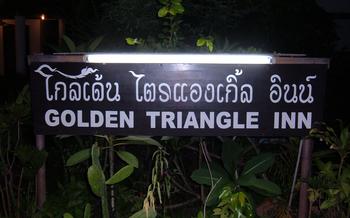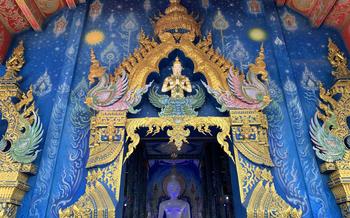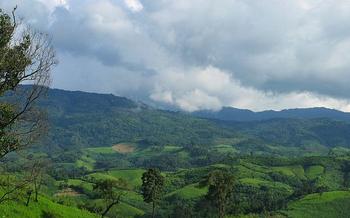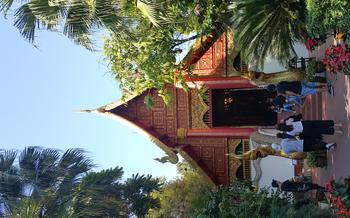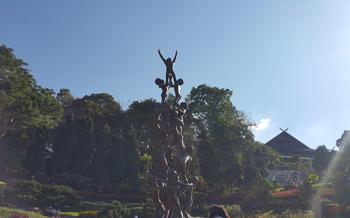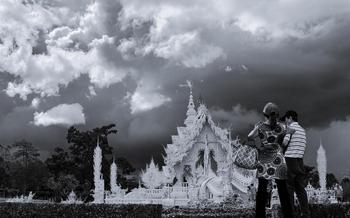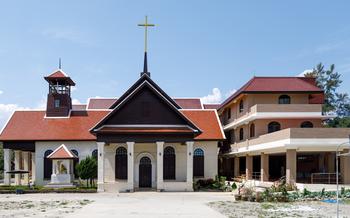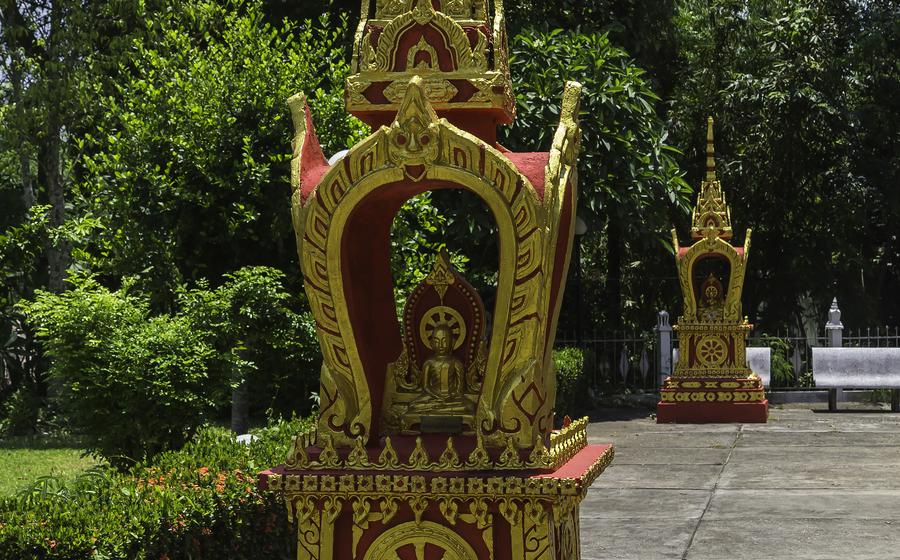
Baandam Museum (The Black House)
- A Masterpiece of Unconventional Art
- Exploring the Black House
- A Journey Through Animal Sculptures
- Intriguing Interior Designs
- A Museum of Wonders
- Embrace the Darkness
- A Place of Reflection
- Beyond the Black House
- Getting There
- Things to Keep in Mind:
- Photography Tips: Capturing the Essence of the Baandam Museum
- When to Visit
- Nearby Attractions
- Insider Tip: Unraveling the Hidden Treasures
A Masterpiece of Unconventional Art
The Baandam Museum, also known as the Black House, is a captivating and unconventional art museum located in Chiang Rai, Thailand. It owes its existence to the creative vision of Thawan Duchanee, a renowned Thai artist who sought to challenge conventional artistic norms. The museum, a product of his artistic genius, stands as a testament to his unique style and vision, attracting visitors from around the world.
Duchanee, driven by his artistic passion, began constructing the Black House in 1997, using a combination of traditional Thai architecture and contemporary design elements. His intention was to create a space that would showcase his unconventional artwork and provide visitors with a thought-provoking and immersive experience. The result is an extraordinary masterpiece that defies categorization, blurring the lines between art, architecture, and philosophy.
Exploring the Black House
The Baandam Museum, also known as the Black House, is a striking example of unconventional architecture and design. The color black is a central theme throughout the museum, symbolizing darkness, mystery, and the hidden aspects of life. This unique architectural style and design reflect the artistic vision and inspiration of Thawan Duchanee, the creator of the museum.
Notable features of the Black House include its dark wooden exterior, intricate carvings, and animal sculptures. The blend of traditional and contemporary elements creates a distinctive aesthetic that sets the museum apart from other architectural wonders in Thailand. Visitors will find themselves immersed in a world of symbolism and philosophy as they explore the various exhibits and installations within the Black House.
The spiritual and philosophical influences on the Black House are evident in its design and decor. Thawan Duchanee drew inspiration from various spiritual traditions, including Buddhism and animism, to create an environment that encourages contemplation and introspection. The museum's dark interiors and thought-provoking exhibits provide a space for visitors to reflect on their own existence and the nature of reality.
A Journey Through Animal Sculptures
The Baandam Museum is home to an abundance of animal sculptures, each holding symbolic and cultural significance. These life-size and larger-than-life creations are meticulously crafted and strategically positioned throughout the museum grounds.
-
Symbolic Meanings: Each animal sculpture represents a specific concept or characteristic. The majestic elephants symbolize strength and wisdom, while the fierce tigers embody power and courage. The intricate dragons showcase the mythical creatures' mystical and protective qualities, while the playful monkeys depict wit and cleverness.
-
Connection to Nature: The sculptures also serve as a testament to Thawan Duchanee's deep connection to nature and the environment. The museum is surrounded by lush greenery, and the sculptures seem to blend seamlessly into the landscape. The artist's profound respect for the natural world is evident in his artistic representations of the animal kingdom.
-
Artistic Representation: The animal sculptures at the Baandam Museum are not merely decorative elements; they are intricate works of art. Thawan Duchanee's exceptional craftsmanship and attention to detail are evident in each piece. The sculptures display a range of expressions, from the serene gaze of a deer to the menacing snarl of a wolf, capturing the essence and character of each animal.
Intriguing Interior Designs
The Baandam Museum's interiors are a captivating blend of eclectic artifacts, recycled materials, and a fusion of Thai, Chinese, and Western influences. Thawan Duchanee's creative genius is evident in every nook and cranny, where ordinary objects are transformed into extraordinary design elements.
Animal bones, skulls, and horns adorn the walls, creating an eerie yet fascinating ambiance. Old furniture, discarded machinery parts, and everyday items find new life as decorative accents, showcasing the artist's ability to see beauty in the discarded and overlooked.
Unique and unexpected spaces abound, from the "Spirit House" with its intricate carvings to the "Bottle House" constructed entirely from recycled glass bottles. Each room tells a story, inviting visitors to explore and discover the hidden meanings and symbolism behind every object.
The eclectic collection of artifacts and objects on display reflects Thawan Duchanee's diverse interests and influences. From traditional Thai crafts to Chinese antiques and Western curiosities, the museum offers a glimpse into the mind of a truly original artist.
Whether it's the intricately carved wooden panels, the colorful ceramic tiles, or the repurposed metal sculptures, the Baandam Museum's interiors are a feast for the eyes and a testament to the boundless creativity of its creator.
A Museum of Wonders
The Baandam Museum is a treasure trove of peculiar and unusual items that ignite curiosity and a sense of wonder. Hidden corners and secret passages lead to unexpected discoveries, creating a captivating atmosphere that keeps visitors enthralled. Among the intriguing exhibits, one can find a collection of animal skulls, antique furniture, and various oddities that defy categorization. The museum's unique charm lies in its ability to surprise and delight visitors at every turn, leaving them with a lasting sense of awe and wonder.
Embrace the Darkness
The Baandam Museum is a unique and immersive experience that embraces the darkness in both a literal and figurative sense. The dark interiors create a mysterious and contemplative atmosphere that enhances the exhibits and evokes a range of emotions. The play of light and shadow adds depth and drama to the displays, highlighting the intricate details and textures of the various artifacts.
The contrast between the black walls and the vibrant colors of the exhibits creates a striking visual effect that draws the eye and captures the imagination. This interplay of light and dark adds to the overall mystique of the museum, creating a sense of wonder and curiosity that lingers long after the visit. The unique atmosphere of the Baandam Museum invites visitors to embrace the darkness and explore the depths of their own creativity and imagination.
A Place of Reflection
The Baandam Museum is not merely a collection of unconventional art; it's a place that encourages introspection and invites visitors to question societal norms. Thawan Duchanee's creations are a testament to his belief that art should not just be visually appealing but should also provoke thought and challenge perspectives.
Throughout the museum, one can find philosophical messages and thought-provoking quotes that inspire contemplation. Duchanee believed that art has the power to transform individuals and society, and his works encourage visitors to examine their own beliefs and values.
The museum's dark and introspective atmosphere creates a contemplative space where visitors can reflect on their own lives and their place in the world. The absence of color and the focus on black and white elements evoke a sense of introspection and encourage visitors to look beyond the surface of things.
The Baandam Museum is not just a museum; it's a place of reflection and self-discovery, where visitors are invited to challenge their perceptions and explore the depths of their own consciousness.
Beyond the Black House
The Baandam Museum is not limited to the iconic Black House. As you explore the extensive grounds, you'll discover a myriad of additional structures and exhibits that add to the museum's allure. Among them, the White Temple (Wat Rong Khun) stands out as a captivating contrast to the Black House. This stunning temple, known for its intricate carvings and mirrored facades, offers a unique and ethereal experience.
Venturing beyond the museum, you can delve into the history and culture of the region by exploring the Golden Triangle. This area, once infamous for its opium trade, now boasts a rich tapestry of ethnic traditions and natural wonders. Explore local markets, visit hill tribe villages, and marvel at the stunning landscapes that define this enigmatic region.
Nature enthusiasts will delight in the opportunity to immerse themselves in the surrounding natural beauty. From lush forests to cascading waterfalls, the area offers a plethora of hiking trails and outdoor activities. Embrace the tranquility of the countryside as you explore the serene surroundings of the Baandam Museum.
Getting There
Reaching the Baandam Museum from Chiang Rai is a breeze. Located just 15 kilometers south of the city center, it takes approximately 30 minutes by car or taxi to arrive at this captivating destination. For those seeking a more immersive experience, consider renting a bicycle and pedaling through the serene countryside, enjoying the lush scenery along the way. Should you prefer public transportation, hop on a local bus or songthaew (shared taxi) from Chiang Rai's main bus station, disembarking at the museum's entrance. Immerse yourself in the local culture as you interact with friendly locals during your journey.
Things to Keep in Mind:
Respectful Behavior and Dress Code:
When visiting temples, it's crucial to exhibit respectful behavior and dress appropriately. This includes dressing modestly, covering shoulders and knees, and avoiding revealing or offensive clothing. Visitors should also refrain from loud talking or disruptive behavior that may disturb others' spiritual practices.
Suitable Footwear:
The Baandam Museum features uneven surfaces and pathways, so it's advisable to wear comfortable and sturdy footwear. High heels or open-toe sandals may not be suitable for navigating the terrain safely and comfortably.
Sun Protection and Hydration:
Chiang Rai experiences warm and sunny weather, especially during the daytime. Visitors should take precautions against the sun by wearing sunscreen, sunglasses, and a hat. It's equally important to stay hydrated by carrying sufficient water or purchasing it from local vendors.
Embrace Local Customs and Etiquette:
Respecting local customs and etiquette enhances the overall travel experience. This includes greeting people with a "wai" (traditional Thai greeting with hands pressed together in a prayer-like gesture), avoiding pointing feet at people or sacred objects, and refraining from touching people's heads, which is considered disrespectful.
Photography Tips: Capturing the Essence of the Baandam Museum
Embrace Low-Light Conditions: The dimly lit interiors of the Black House present a unique challenge for photography enthusiasts. Embrace this darkness and utilize low-light photography techniques to capture the essence of the museum. Experiment with longer exposure times, higher ISO settings, and a tripod for stability to minimize blur and noise.
Play with Angles and Perspectives: The unconventional architecture of the Baandam Museum offers endless opportunities for creative photography. Move around the structures, explore different angles, and play with perspectives to showcase the unique features of the buildings. Experiment with wide-angle lenses to accentuate the scale and grandeur of the structures.
Highlight Architectural Details: The Baandam Museum is adorned with intricate carvings, sculptures, and other architectural details. Use a macro lens or zoom in with your camera to capture these details, highlighting the craftsmanship and creativity that went into creating this extraordinary space.
Capture the Play of Light and Shadow: The interplay of light and shadow within the Baandam Museum adds depth and drama to the atmosphere. Position yourself to capture the way light filters through the windows, creating dramatic shadows and silhouettes. Use these contrasts to enhance the mood and mystery of your photographs.
Convey the Museum's Atmosphere: Beyond capturing the physical structures, aim to convey the overall atmosphere and energy of the Baandam Museum. Experiment with different shutter speeds to capture motion blur, creating a sense of movement and dynamism. Use post-processing techniques to adjust colors and tones, enhancing the mood and emotions evoked by the museum's unique environment.
When to Visit
The best time to visit the Baandam Museum, and Chiang Rai in general, is during the cool and dry season from November to February. Temperatures are pleasant, with average highs in the mid-20s Celsius, making it ideal for exploring the outdoor areas of the museum. The skies are mostly clear, providing excellent lighting conditions for photography.
Avoid visiting during the hot season from March to May, as temperatures can soar to uncomfortable levels, especially during the day. The humidity is also high, making it feel even hotter. The rainy season, which runs from June to October, brings heavy rainfall, which can disrupt outdoor activities and make exploring the museum grounds challenging.
If you're interested in experiencing local festivals and events, plan your visit accordingly. The Chiang Rai Flower Festival, held annually in February, showcases stunning floral displays and parades. The Loi Krathong and Yi Peng festivals, celebrated in November, feature floating lanterns and fireworks, creating a magical atmosphere.
Insider Tip: For a truly unique experience, consider visiting the Baandam Museum during the full moon. The museum takes on a different ambiance under the moonlight, casting eerie shadows and creating a mystical atmosphere.
Nearby Attractions
Chiang Rai offers a wealth of additional attractions beyond the Baandam Museum. For a comprehensive cultural experience, visit the Chiang Rai National Museum to delve into the region's rich history and heritage. Explore the stunning Wat Rong Khun (White Temple), an architectural marvel renowned for its intricate details and unique design.
Nature enthusiasts can embark on a journey to the Golden Triangle, where the borders of Thailand, Laos, and Myanmar converge. Witness the confluence of the mighty Mekong and Ruak rivers and explore the fascinating history of the region, once known for opium cultivation.
Immerse yourself in the natural beauty of Chiang Rai by visiting picturesque waterfalls, lush forests, and stunning viewpoints. Discover hidden gems such as the Khun Korn Forest Park or the Mae Fah Luang Garden, showcasing breathtaking landscapes and diverse flora and fauna.
Combine your visit to the Baandam Museum with other activities to create a memorable itinerary. Embark on a day trip to the nearby Elephant Sanctuary to interact with these gentle giants in a responsible and ethical manner. Alternatively, explore the vibrant night market in Chiang Rai, where you can indulge in delicious local cuisine, shop for souvenirs, and experience the lively atmosphere.
Insider Tip: Unraveling the Hidden Treasures
Beyond the main exhibits, the Baandam Museum holds a treasure trove of hidden gems waiting to be discovered. Explore the intricate details of the wooden carvings adorning the walls, each telling a unique story. Ascend the narrow staircase to the rooftop terrace and be rewarded with panoramic views of the lush surroundings.
Seek out the secret passageways that lead to unexpected corners, revealing hidden sculptures and installations. Engage with the friendly staff, who are always eager to share fascinating anecdotes and insights about the museum's history and significance.
For a truly immersive experience, plan your visit during one of the special events or workshops hosted by the Baandam Museum. These events offer a deeper understanding of Thai culture, art, and philosophy, allowing you to connect with the museum's spirit on a profound level.

